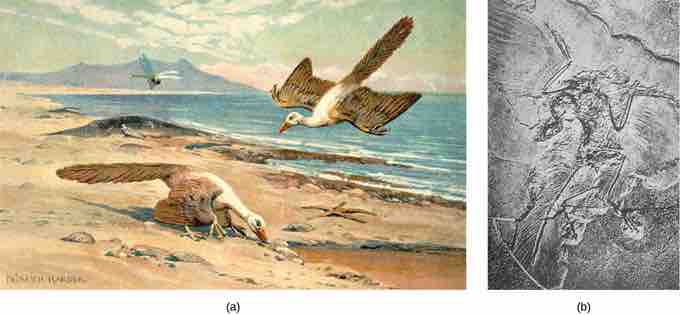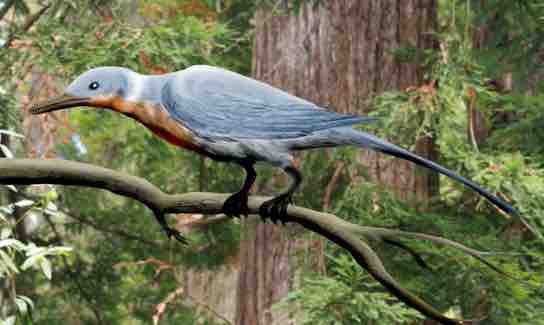Evolution of Birds
The evolutionary history of birds is still somewhat unclear. Due to the fragility of bird bones, they do not fossilize as well as other vertebrates. Birds are diapsids, meaning they have two fenestrations, or openings, in their skulls. Birds belong to a group of diapsids called the archosaurs, which also includes crocodiles and dinosaurs. It is commonly accepted that birds evolved from dinosaurs.
Dinosaurs were subdivided into two groups, the Saurischia ("lizard like") and the Ornithischia ("bird like"). Despite the names of these groups, it was not the bird-like dinosaurs that gave rise to modern birds. Rather, Saurischia diverged into two groups. One included the long-necked herbivorous dinosaurs, such as Apatosaurus. The second group, bipedal predators called theropods, includes the ancestors of modern birds. This course of evolution is suggested by similarities between theropod fossils and birds, specifically in the structure of the hip and wrist bones, as well as the presence of the wishbone, formed by the fusing of the clavicles.
One important fossil of an animal intermediate to dinosaurs and birds is Archaeopteryx, which is from the Jurassic period and has characteristics of both dinosaurs and birds . Some scientists propose classifying it as a bird, but others prefer to classify it as a dinosaur. The fossilized skeleton of Archaeopteryx looks like that of a dinosaur. It had teeth and birds do not, but it also had feathers modified for flight, a trait associated only with birds among modern animals. Fossils of older, feathered dinosaurs exist, but the feathers do not have the characteristics of flight feathers.

Bird fossils
(a) Archaeopteryx lived in the late Jurassic Period around 150 million years ago. It had teeth like a dinosaur, but had (b) flight feathers like modern birds, which can be seen in this fossil.
It is still unclear exactly how flight evolved in birds. Two main theories exist: the arboreal ("tree") hypothesis and the terrestrial ("land") hypothesis. The arboreal hypothesis posits that tree-dwelling precursors to modern birds jumped from branch to branch using their feathers for gliding before becoming fully capable of flapping flight. In contrast to this, the terrestrial hypothesis holds that running was the stimulus for flight, as wings could be used to improve running and then became used for flapping flight. As with the question of how flight evolved, the question of how endothermy evolved in birds still is unanswered. Feathers provide insulation, but this is only beneficial if body heat is being produced internally. Similarly, internal heat production is only viable if insulation is present to retain that heat. It has been suggested that one or the other (feathers or endothermy) evolved in response to some other selective pressure.
During the Cretaceous period, a group known as the Enantiornithes was the dominant bird type . Enantiornithes means "opposite birds," which refers to the fact that certain bones of the feet are joined differently than the way the bones are joined in modern birds. These birds formed an evolutionary line separate from modern birds; they did not survive past the Cretaceous. Along with the Enantiornithes, Ornithurae birds (the evolutionary line that includes modern birds) were also present in the Cretaceous. After the extinction of Enantiornithes, modern birds became the dominant bird, with a large radiation occurring during the Cenozoic Era. Referred to as Neornithes ("new birds"), modern birds are now classified into two groups, the Paleognathae ("old jaw") or ratites (a group of flightless birds including ostriches, emus, rheas, and kiwis) and the Neognathae ("new jaw"), all other birds.

Example of an extinct bird
Shanweiniao cooperorum was a species of Enantiornithes, which evolved separately from modern birds. It did not survive past the Cretaceous period.